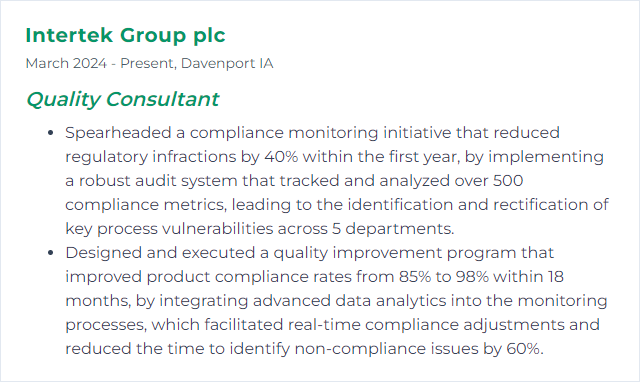Top 12 Quality Consultant Skills to Put on Your Resume
In today's job market, a resume that hums with relevance and precision matters more than ever. Quality consultants who show a sharp mix of technical depth, systems thinking, and business sense stand out fast. Lead with substance, back it with outcomes, and your profile does the heavy lifting.
Quality Consultant Skills
- ISO 9001
- Lean Six Sigma
- Auditing
- Statistical Analysis
- Risk Management
- Process Improvement
- Quality Management Systems (QMS)
- SAP Quality Module
- Root Cause Analysis
- Continuous Improvement
- Project Management
- Compliance Monitoring
1. ISO 9001
ISO 9001 sets out requirements for a quality management system. It helps organizations consistently meet customer and regulatory expectations while driving continual improvement. For a Quality Consultant, it’s the backbone: structure, clarity, measurable outcomes.
Why It's Important
It gives a shared language for quality, anchors leadership accountability, and turns customer needs into disciplined processes that actually deliver.
How to Improve ISO 9001 Skills
Make the system breathe, not just exist. Practical moves:
Run a gap analysis: Compare current practices to ISO 9001 clauses; map nonconformities and improvement opportunities.
Activate leadership: Clarify roles, objectives, and resources. Tie quality goals to business goals—visibly.
Grow competence: Targeted training, role-based awareness, and job aids. Make it easy to do the right thing.
Tighten documentation: Clear, lean, controlled. Emphasize process ownership and single sources of truth.
Obsess over customer feedback: Capture, analyze, close the loop. Build metrics around satisfaction and complaints.
Embed PDCA: Small cycles, quick wins, sustained cadence. Blend in Lean or Six Sigma where it fits.
Audit with purpose: Use ISO 19011 principles. Risk-based sampling. Findings that spark action, not paperwork.
Hold sharp management reviews: Evidence, trends, risks, resources, and decisions—not status theater.
Benchmark wisely: Compare practices and outcomes against peers. Borrow what works; skip the fluff.
Use tech where it helps: Document control, CAPA tracking, dashboards. Visibility reduces drift.
When the QMS becomes the way work happens, performance follows.
How to Display ISO 9001 Skills on Your Resume
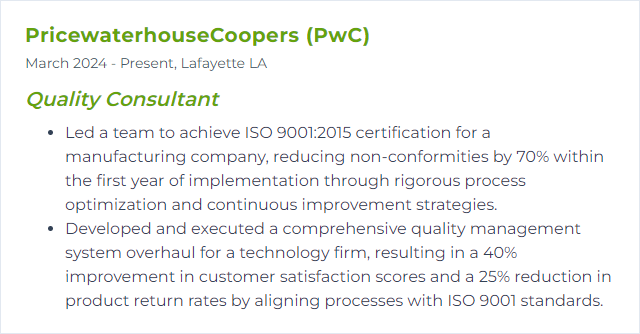
2. Lean Six Sigma
Lean trims waste. Six Sigma smashes variation. Together, they sharpen flow, quality, and speed. A pragmatic toolbox with a data spine.
Why It's Important
It turns guesswork into disciplined improvement, unlocking cost, cycle time, and defect reductions that actually stick.
How to Improve Lean Six Sigma Skills
Keep your edge through practice and reflection:
Stay current: Refresh on DMAIC/DMADV, flow analysis, problem framing, change management.
Do real projects: Aim for measurable financial and customer impacts; publish before/after metrics.
Master the tools: Value stream mapping, hypothesis testing, DOE, control plans. Use statistical software confidently.
Coach others: Mentor belts and teams. Teaching solidifies judgment.
Tailor solutions: Every process has constraints. Customize; avoid templated fixes.
Build sustainment: Visual controls, standard work, layered audits. No backsliding.
Results over rituals—always.
How to Display Lean Six Sigma Skills on Your Resume
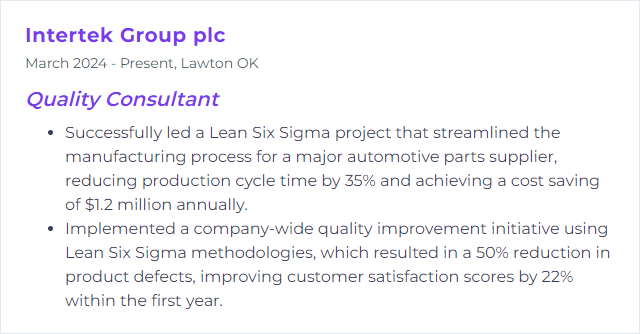
3. Auditing
Auditing examines how processes run versus how they should, using evidence to confirm compliance and reveal risk. It’s not about fault-finding—it’s about truth-finding.
Why It's Important
Good audits protect customers, reputations, and balance sheets. They spotlight weak signals before they become loud failures.
How to Improve Auditing Skills
Make audits insightful, not performative:
Follow recognized guidance: Use ISO 19011 and industry practices to plan, sample, and report.
Go risk-based: Focus effort where the consequence is highest.
Use data: Trend nonconformities, repeat issues, and process KPIs to steer scope.
Engage stakeholders: Listen well, probe respectfully, align on facts and actions.
Assure quality of the audit: Peer reviews, calibrated checklists, evidence trails.
Close the loop: Strong CAPA, verified effectiveness, lessons shared.
Clarity, integrity, and impact—those are the marks of a serious audit.
How to Display Auditing Skills on Your Resume
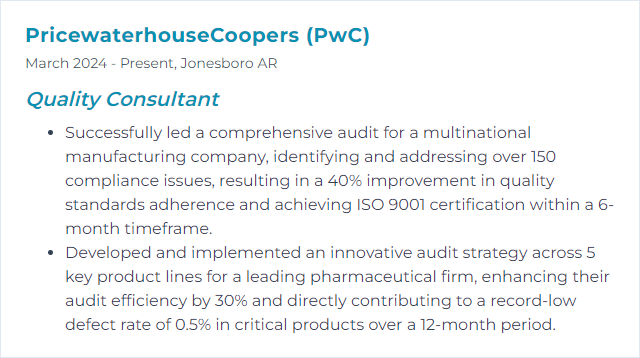
4. Statistical Analysis
Statistics turns raw noise into signal. Patterns, significance, confidence—decisions that carry weight.
Why It's Important
Without data discipline, quality efforts drift. With it, you target the right fix the first time and prove it worked.
How to Improve Statistical Analysis Skills
Sharpen both theory and practice:
Deepen fundamentals: Sampling, regression, DOE, control charts, nonparametrics. Know when and why.
Upgrade tools: Proficiency in R, Python, or SAS for advanced analysis and visualization.
Elevate data quality: Clean inputs, clear definitions, robust governance. Bad data ruins good models.
Choose methods that fit: Align techniques to the question, not the other way around.
Validate and peer review: Replicate analyses, stress-test assumptions, invite critique.
Connect to business outcomes: Tie findings to risk, cost, and customer experience.
Precision beats volume—better questions, better answers.
How to Display Statistical Analysis Skills on Your Resume
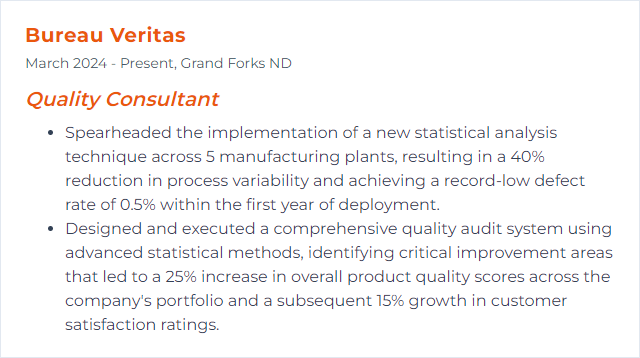
5. Risk Management
Risk management identifies what could go wrong, how likely, and how bad—then shapes smart responses. For quality, that means fewer surprises and sturdier outcomes.
Why It's Important
It protects compliance, safety, timelines, and cost. It also uncovers upside: resilience and trust.
How to Improve Risk Management Skills
Work the lifecycle end to end:
Identify broadly: Process, supplier, technology, regulatory, human error, environment.
Analyze clearly: Impact versus likelihood; use risk matrices, FMEA, fault trees.
Prioritize with intent: Focus on critical few.
Plan responses: Avoid, reduce, transfer, accept—own the choice.
Implement controls: Standard work, poka‑yoke, monitoring, training.
Track and review: Update registers, test controls, respond to change.
Communicate: Transparent, regular, decision-ready updates for stakeholders.
Consistent rhythm beats one-time risk workshops every time.
How to Display Risk Management Skills on Your Resume
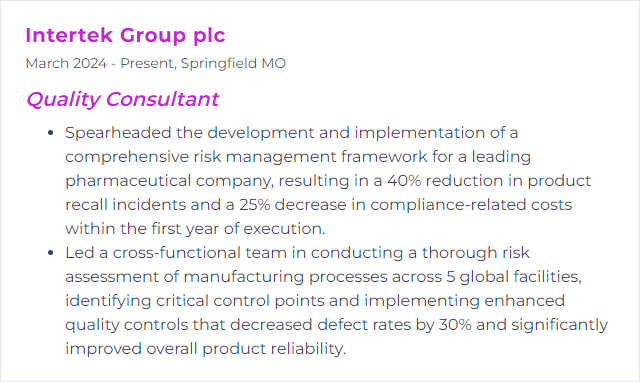
6. Process Improvement
Process improvement streamlines how work flows so outcomes improve—fewer defects, faster cycles, lower cost, happier customers.
Why It's Important
Because better processes compound. Today’s gains become tomorrow’s baseline.
How to Improve Process Improvement Skills
Build momentum through structure and iteration:
Study the current state: Process maps, gemba walks, time studies, voice of customer.
Set sharp objectives: Specific, measurable, time-bound, aligned to strategy.
Apply proven methods: Lean, Six Sigma, and TQM—use what fits the problem.
Involve people: Operators, owners, customers. Co-create change.
Pilot, then scale: Use controlled tests, measure, and codify before rollout.
Reinforce change: Visual management, standard work, tiered huddles.
Leverage technology: Process mining, automation where waste hides.
Review relentlessly: Audit against targets and refresh as conditions shift.
Small, steady improvements beat sporadic overhauls.
How to Display Process Improvement Skills on Your Resume
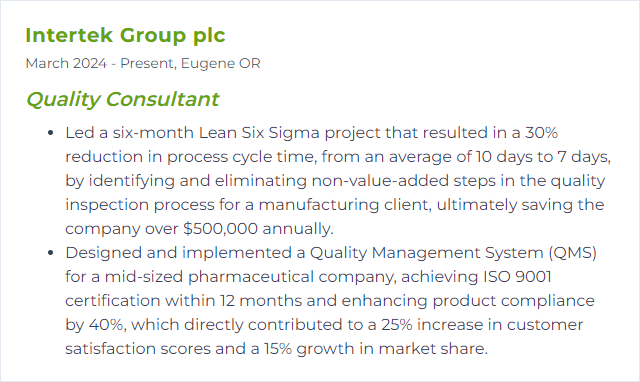
7. Quality Management Systems (QMS)
A QMS organizes policy, process, and evidence into a coherent system that produces consistent quality. It connects purpose with practice.
Why It's Important
It drives predictable outcomes, regulatory compliance, cost control, and customer trust—without constant heroics.
How to Improve Quality Management Systems (QMS) Skills
Make the QMS lean, lived, and data-led:
Run a structured gap check: Compare against ISO 9001; prioritize by risk and impact.
Engage the organization: Clear ownership, cross-functional inputs, visible KPIs.
Simplify processes: Reduce handoffs, eliminate redundancies, define interfaces.
Adopt enabling tools: QMS platforms for document control, audits, CAPA, and metrics.
Invest in capability: Regular training and refreshers for roles that drive the system.
Embed PDCA: Continuous loops at process and system levels.
Audit smart: Internal audits that generate learning, not just findings.
Use customer input: Feedback, complaints, returns—convert into actions and design updates.
Benchmark: Compare maturity, not just checklists; borrow mechanisms that scale.
Align leadership reviews: Decisions on resources, priorities, and risk—captured and tracked.
When the QMS aligns with how work actually happens, it accelerates performance instead of slowing it down.
How to Display Quality Management Systems (QMS) Skills on Your Resume

8. SAP Quality Module
SAP Quality Management (QM) weaves quality into procurement, manufacturing, and logistics. Inspections, planning, results, and certificates—integrated end to end.
Why It's Important
Quality data travels with the material and the order. That linkage cuts errors, speeds decisions, and strengthens compliance.
How to Improve SAP Quality Module Skills
Turn configuration into capability:
Assess current config: Map master data, inspection types, catalogs, usage decisions, and flows.
Standardize approaches: Common specs, plans, and codes across plants and vendors.
Integrate deeply: Tighten touchpoints with MM, PP, SD, PM—no islands of data.
Automate: Triggers, workflows, notifications, and status updates that reduce manual steps.
Advance quality planning: Robust inspection plans, sampling procedures, and control characteristics.
Train users: Role-based guides and simulations. Confidence reduces workarounds.
Use analytics: Reports and dashboards on defect trends, supplier performance, and cost of quality.
Stay current: Review release notes and enhancements; adopt what adds value.
Build a feedback loop: Collect pain points and iterate configuration accordingly.
Good master data plus stable processes equals clean signals and fewer surprises.
How to Display SAP Quality Module Skills on Your Resume
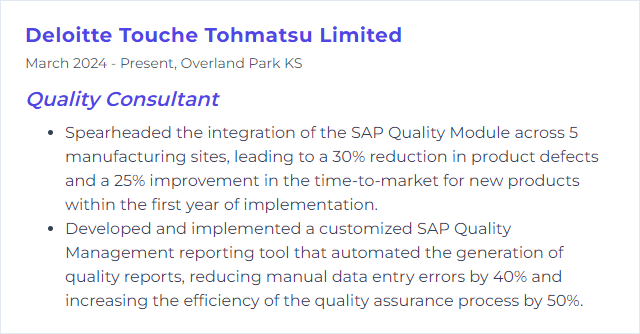
9. Root Cause Analysis
RCA hunts for the underlying mechanism, not the nearest excuse. Fix the cause; prevent the replay.
Why It's Important
It converts recurring headaches into one-time lessons—and turns CAPA into capability.
How to Improve Root Cause Analysis Skills
Disciplined, curious, evidence-based:
Define the problem crisply: Scope, impact, when/where seen, what not affected.
Collect facts: Timelines, process data, photos, operator notes, environmental conditions.
Frame causes: Fishbone diagrams, 5 Whys, Pareto to focus attention.
Go deeper: FMEA, fault tree, and experiments to test hypotheses.
Implement corrective and preventive actions: Address system causes—standards, training, design, controls.
Verify effectiveness: Monitor metrics over time; audit for slip-back.
Share learning: Document clearly; update standards and training.
Evidence over opinion—every time.
How to Display Root Cause Analysis Skills on Your Resume

10. Continuous Improvement
CI is the drumbeat. Incremental tweaks or step-change leaps—both count, if they stick.
Why It's Important
It keeps quality from ossifying. Markets shift; your systems should evolve just as fast.
How to Improve Continuous Improvement Skills
Build culture and cadence:
Assess reality: Baselines, bottlenecks, and customer pain points.
Set SMART goals: Clear targets tied to strategy.
Engage everyone: Kaizen mindsets, suggestion systems, leader standard work.
Run PDCA: Small tests, quick learning, broaden what works.
Use Lean Six Sigma where apt: The right tool at the right time.
Develop people: Train, coach, and recognize contributions.
Track visibly: Obeya walls, KPI boards, and narrative metrics.
Celebrate wins: Momentum matters.
Sustainment is the superpower.
How to Display Continuous Improvement Skills on Your Resume

11. Project Management
Project management orchestrates people, scope, time, and money so quality deliverables land as promised. Plans meet reality; tradeoffs get managed, not ignored.
Why It's Important
It ensures quality doesn’t become an afterthought. Governance, cadence, and clarity keep outcomes on track.
How to Improve Project Management Skills
Blend rigor with adaptability:
Standardize quality within projects: Stage gates, acceptance criteria, and definition of done.
Use fit-for-purpose tools: Task tracking, risk registers, and dashboards that make status obvious.
Communicate obsessively: Clear roles, crisp updates, rapid issue escalation.
Apply PDCA to the project itself: Retrospectives, lessons learned, process tweaks mid-flight.
Grow professionally: Frameworks like PMBOK (latest edition) or PRINCE2 can sharpen practice.
Manage risk actively: Identify, analyze, own, and act—early and often.
Align stakeholders: Expectations, scope, and success criteria locked and visible.
Predictable delivery is a competitive advantage.
How to Display Project Management Skills on Your Resume
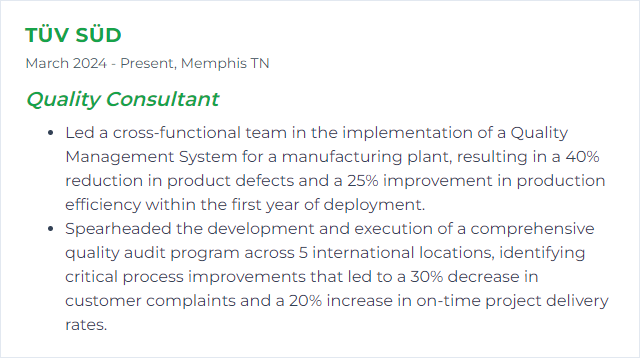
12. Compliance Monitoring
Compliance monitoring checks whether operations align with laws, standards, and internal rules. Quietly essential, loudly protective.
Why It's Important
It minimizes legal exposure, safeguards reputation, and proves control to regulators and customers alike.
How to Improve Compliance Monitoring Skills
Systematic, documented, responsive:
Assess risk: Map regulatory obligations and internal policy risks across functions.
Set clear policies and procedures: Current, accessible, and owned.
Train continuously: Role-relevant, scenario-based, with comprehension checks.
Monitor and audit: Automated checks where feasible; targeted audits where impact is high.
Enable reporting: Safe, confidential channels and non-retaliation policies.
Review and refresh: Update programs as regulations change and risks evolve. Consider ISO 37301 for compliance management guidance.
Drive corrective action: Root cause, timely remediation, verified effectiveness.
Compliance thrives when it’s woven into daily work, not bolted on.
How to Display Compliance Monitoring Skills on Your Resume
